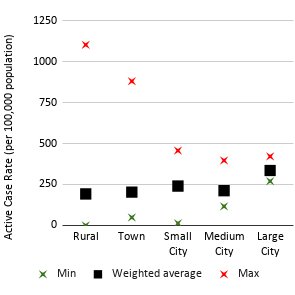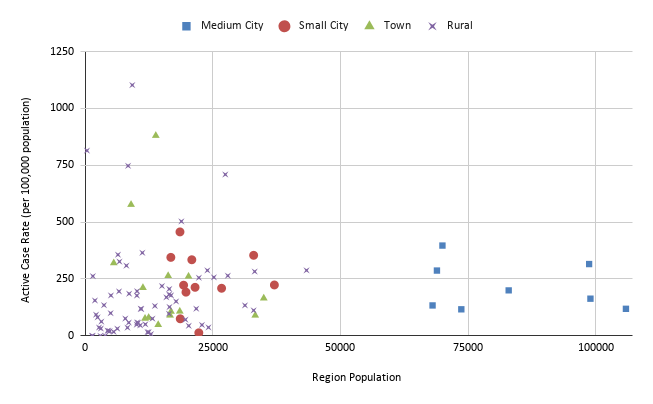Do differences in case loads explain Alberta& #39;s urban/rural divide on approval of COVID measures? Not really, no. At least not with Wave 2. [Thread] #ableg #abhealth
I& #39;ve heard it speculated a number of times (most recently on @strategistspod) that lower rural case rates explain weaker support for COVID restrictions in rural communities, among UCP rural base, and/or among UCP rural caucus.
I think that people are grasping for rational non-ideological factors for what seem like inexplicable opposition to life-saving measures. And outbreaks being disproportionately urban *feels* right.
And I think there is something to this assumption for Wave 1 (which was really a Calgary + meatpacking outbreak wave). But not Wave 2.
Here is a graph of weighted average active cases in each of 5 different "region" types. Some insights from this.
First: no category of communities deviates from the provincial average by more than 30%. Cases are rising exponentially in all categories.
Second: the variability between communities *within* "rural" categories (rural municipalities and small towns) is much larger than the variation between rural and urban categories.
Third: there are some rural municipalities and small towns with *very* high case rates. More on that later.
You can try to make out whether the population of a "region" (the closest I can get to a notion of density) has any impact on case rates, in this scatter plot. Good luck. Across all categories, the trendline& #39;s R-squared value is 0.017.
[NB: Chart excludes Edmonton (422/100,000) and Calgary (270), because population is an order of magnitude to the right. They were included in the trendline analysis.]
[NB2: placed Strathcona County and Wood Buffalo in medium cities category because of the concentration of their populations in mid-sized city settings.]
If you want to *ensure* that you are around a low case rate, your best bet at this time is to choose a mid-sized city that is not a bedroom community (Airdrie, Strathcona and St. Albert are the >250 blue squares in the scatter plot).
The >250 small cities are also all bedroom communities (Beaumont, Leduc, Wetaskiwin, Chestermere, Spruce Grove).
Smaller communities& #39; rates are just too susceptible with their small denominators to outbreaks. Some have no cases. Others are much higher than the big cities.
As of Nov 22 data, there are 5 rural municipalities, 2 towns and one small city with higher active case rates than either Edmonton (422/100,000), Calgary (270) or any of the eight medium-sized cities (highest: Airdrie, 397).
5 rural municipalities:
 https://abs.twimg.com/emoji/v2/... draggable="false" alt="😷" title="Gesicht mit Mundschutz" aria-label="Emoji: Gesicht mit Mundschutz"> Vulcan County: 1,103
https://abs.twimg.com/emoji/v2/... draggable="false" alt="😷" title="Gesicht mit Mundschutz" aria-label="Emoji: Gesicht mit Mundschutz"> Vulcan County: 1,103
 https://abs.twimg.com/emoji/v2/... draggable="false" alt="😷" title="Gesicht mit Mundschutz" aria-label="Emoji: Gesicht mit Mundschutz"> MD Acadia: 815
https://abs.twimg.com/emoji/v2/... draggable="false" alt="😷" title="Gesicht mit Mundschutz" aria-label="Emoji: Gesicht mit Mundschutz"> MD Acadia: 815
 https://abs.twimg.com/emoji/v2/... draggable="false" alt="😷" title="Gesicht mit Mundschutz" aria-label="Emoji: Gesicht mit Mundschutz"> Smoky Lake County: 748
https://abs.twimg.com/emoji/v2/... draggable="false" alt="😷" title="Gesicht mit Mundschutz" aria-label="Emoji: Gesicht mit Mundschutz"> Smoky Lake County: 748
 https://abs.twimg.com/emoji/v2/... draggable="false" alt="😷" title="Gesicht mit Mundschutz" aria-label="Emoji: Gesicht mit Mundschutz"> Ponoka County: 710
https://abs.twimg.com/emoji/v2/... draggable="false" alt="😷" title="Gesicht mit Mundschutz" aria-label="Emoji: Gesicht mit Mundschutz"> Ponoka County: 710
 https://abs.twimg.com/emoji/v2/... draggable="false" alt="😷" title="Gesicht mit Mundschutz" aria-label="Emoji: Gesicht mit Mundschutz"> MD Taber: 504
https://abs.twimg.com/emoji/v2/... draggable="false" alt="😷" title="Gesicht mit Mundschutz" aria-label="Emoji: Gesicht mit Mundschutz"> MD Taber: 504
2 towns:
 https://abs.twimg.com/emoji/v2/... draggable="false" alt="😷" title="Gesicht mit Mundschutz" aria-label="Emoji: Gesicht mit Mundschutz"> Banff: 881
https://abs.twimg.com/emoji/v2/... draggable="false" alt="😷" title="Gesicht mit Mundschutz" aria-label="Emoji: Gesicht mit Mundschutz"> Banff: 881
 https://abs.twimg.com/emoji/v2/... draggable="false" alt="😷" title="Gesicht mit Mundschutz" aria-label="Emoji: Gesicht mit Mundschutz"> Drumheller: 577
https://abs.twimg.com/emoji/v2/... draggable="false" alt="😷" title="Gesicht mit Mundschutz" aria-label="Emoji: Gesicht mit Mundschutz"> Drumheller: 577
Some of these certainly have exceptional circumstances causing this. Banff is obviously a unique town (Canmore& #39;s rates are also high). Others have had large, centralized outbreaks overwhelming their population denominators (Drumheller penitentiary).
But the point is: it& #39;s not so easy to say that rural Alberta has been spared, or use that to explain hypothetical rural caucus opposition.
If you& #39;re Grant Hunter, Nate Horner, Miranda Rosin, Glenn van Dijken, or Ron Orr, you have outbreaks in your towns and/or MDs/counties.
And if you& #39;re Joseph Schow, you have the heaviest case rate in Vulcan County, at 1,103 per 100,000. To put that in perspective, roughly one in every 100 people in the county have an active case.
Remember that cases are only positive tests, and we don& #39;t catch all the infections with tests. Last serology data we& #39;ve heard, we catch 17% of cases. As that& #39;s all we have to go on, we have to rely on it. It suggests one in every 15 people in Vulcan County are currently infected.
So, just imagine your grocery shopping, work, or whatever outings, and realize what 1/15 means. That& #39;s really not something that a rural MLA can ignore.

 Read on Twitter
Read on Twitter



